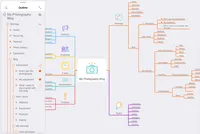Google for Creators
How mind mapping can help creators make better content

Creativity can be a messy process. Great ideas and inspiration don’t come easily on command, or in any organized way. And even when we’re in the creative zone, our brains can sometimes get too overloaded and overwhelmed to actually get anything done. That’s why some people use mind mapping, or visual brainstorming, to stay on top of their game.
Markus Müller-Simhofer, founder of the digital mind mapping app MindNode, saw major changes when he started visualizing his creative process. He recalls the first time he realized what a powerful tool mind mapping could be. While developing an app, Markus found that although he had tons of ideas, he wasn’t making any progress. “Out of this frustration, I started to look into techniques to sort my ideas and find focus. Mind mapping best fit how my brain works,” he says.
Mind mapping worked so well for Markus that he eventually scrapped his original app idea and started developing MindNode. “This was 14 years ago and today, I am still working on it — together with a team of 10 people.”
We recently chatted with Markus about how creators can use mind mapping to make better content.
MindNode founder Markus Müller-Simhofer says mind mapping helped him focus his creativity when other techniques failed.

How would you describe mind mapping to someone who's never used the technique before?
Mind mapping is a simple visual brainstorming technique. Every mind map has a main idea or topic at its center. From this, other thoughts branch out, forming a tree representation of your idea. Let me give you an example: when you start thinking about starting a new photography blog, your head is spinning with ideas like “what should I write about?” or “how should I start?” A mind map is perfect in this situation. Start with “My Photography Blog" as the central topic, and start collecting all of your thoughts and ideas around it. Reorganize them as you go to create a clear picture out of that fuzzy thought in your head.
Are there any creative fields that are especially drawn to visual planning?
We have heard from many people — scriptwriters, novelists, bloggers, photographers, artists, developers, beekeepers, wedding planners, students, teachers — who have used MindNode to help them visualize their thoughts, plan their projects and brainstorm ideas. There are no limitations to what mind maps can be used for, and who can create them.
How can mind mapping help disorganized people find order?
If you’re disorganized, you might miss an important puzzle piece or connection to the bigger picture. That is simply not possible with a mind map. The process of putting your thoughts down, and forming them into a structure creates an overview and allows you to look at things from different perspectives. It helps you create a road map, prioritize what's important and let the organization happen organically.
MindNode allows users to create mind maps on their phones, tablets and computers.

What are the advantages of mind mapping on your computer or phone rather than using pen and paper?
Digital mind maps have the added advantage of no page size restrictions. Your document — and your idea — can grow in any direction. On a digital mind map, you can also easily move your thoughts around, or use features to highlight parts of a mind map. Usually, a mind map is only the start of your idea’s journey. With an app, you can easily export it to other tools to organize your projects or write an article.
Beyond brainstorming new content, how else can mind mapping help content creators?
Mind maps can go far beyond brainstorming. You can use them to take structured notes, study a new topic, keep track of a project, or create your own personal library of information to reference in the future. They're great tools to capture a spark of inspiration, and develop it down the line.
What are some specific MindNode features that are especially helpful for bloggers or other digital content creators?
We have put a lot of thought and effort into MindNode so it’s simple to use and offers users all of the features they might need to bring their ideas to life. Outlining lets you write out your thoughts in a linear, more organized fashion. Focus Mode helps you concentrate on a single area of your mind map by fading out the rest. And with Visual Tags, you can add more context to your map and keep track of your projects by transforming them into tasks.





